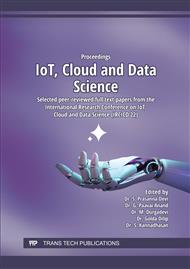[1]
Kertes PJ, Johnson TM, eds. (2007). Evidence Based Eye Care. Philadelphia, PA: Lippincott Williams & Wilkins. ISBN 0-7817- 6964-7.
Google Scholar
[2]
J. Diabetic retinopathy". Diabetes.co.uk. Retrieved 25 November 2012.I. S. Jacobs and C. P. Bean, "Fine particles, thin films and exchange anisotropy,, in Magnetism, vol. III, G. T. Rado and H. Suhl, Eds. New York: Academic, 1963, p.271–350.
Google Scholar
[3]
Tapp RJ, Shaw JE; Harper CA; et al. (June 2003). The prevalence of and factors associated with diabetic retinopathy in the Australian population,. Diabetes Care. 26 (6): 1731–7.
Google Scholar
[4]
Doshi, A. Shenoy, D. Sidhpura and P. Gharpure, Diabetic retinopathy detection using deep convolutional neural networks,, 2016 International Conference on Computing, Analytics and Security Trends (CAST), Pune, 2016, pp.261-266.
DOI: 10.1109/cast.2016.7914977
Google Scholar
[5]
Patel, S Diabetic Retinopathy Detection and Classification using Pre-trained Convolutional Neural Networks., International Journal on Emerging Technologies, 11(3): 1082–1087, (2020).
Google Scholar
[6]
Sairaj Burewar, Anil Balaji Gonde, Santosh Kumar Vipparthi. Diabetic Retinopathy Detection by Retinal segmentation with Region merging using CNN,, 2018 IEEE 13th International Conference on Industrial and Information Systems (ICIIS), (2018).
DOI: 10.1109/iciinfs.2018.8721315
Google Scholar
[7]
K. Gangwar and V. Ravi, Diabetic retinopathy detection using transfer learning and deep learning,, in Evolution in Computational Intelligence, Singapore, (2021).
Google Scholar
[8]
G. T. Reddy, S. Bhattacharya, S. S. Ramakrishnan et al., An ensemble based machine learning model for diabetic retinopathy classification,, in Proceedings of the International Conference on Emerging Trends in Information Technology and Engineering (ic- ETITE), Vellore, India, February (2020).
DOI: 10.1109/ic-etite47903.2020.235
Google Scholar
[9]
S. Gupta, A. Panwar, S. Goel, A. Mittal, R. Nijhawan, and S. A. Kumar, Classification of lesions in retinal fundus images for diabetic retinopathy using transfer learning,, in Proceedings of the International Conference on Information Technology (ICIT), Bhubaneswar, India, December (2019).
DOI: 10.1109/icit48102.2019.00067
Google Scholar
[10]
Q. H. Nguyen, R. Muthuraman, L. Singh et al., Diabetic retinopathy detection using deep learning,, in Proceedings of the 4th International Conference on Machine Learning and Soft Computing, Haiphong City, Vietnam, January (2020).
DOI: 10.1145/3380688.3380709
Google Scholar
[11]
Harry Pratt, Frans Coenen, Deborah M. Broadbent, Simon P. Harding, Yalin Zheng. (2016). Convolutional Neural Networks for Diabetic Retinopathy, Procedia Computer Science, 90, 200-205.
DOI: 10.1016/j.procs.2016.07.014
Google Scholar
[12]
Lam, C., Yi, D., Guo, M., & Lindsey, T. (2018). Automated Detection of Diabetic Retinopathy using Deep Learning. AMIA Joint Summits on Translational Science proceedings. AMIA Joint Summits on Translational Science, 147–155.
Google Scholar
[13]
Gulshan, V., Peng, L., Coram, M., Stumpe, M. C., Wu, D., Narayanaswamy, A., Venugopalan, S., Widner, K., Madams, T., Cuadros, J., Kim, R., Raman, R., Nelson, P. C., Mega, J. L., & Webster, D. R. (2016). Development and Validation of a Deep Learning Algorithm for Detection of Diabetic Retinopathy in Retinal Fundus Photographs. JAMA, 316(22), 2402–2410. https://doi.org/10.1001/jama.2016.17216.
DOI: 10.1001/jama.2016.17216
Google Scholar
[14]
Patel, S. (2020). A Comprehensive Analysis of Convolutional Neural Network Models. International Journal of Advanced Science and Technology, 29(04), 771 - 777. Retrieved from http://sersc.org/journals/index.php/IJAST/article/view/4654.
Google Scholar
[15]
Patel R, Patel S. (2020). A Comprehensive Study of Applying Convolutional Neural Network for Computer Vision. International Journal of Advanced Science and Technology, 29(6s), 2161-2174. Retrieved from http://sersc.org/journals/index.php/IJAST/article/view/10929.
Google Scholar
[16]
Andrew G. Howard, Menglong Zhu, Bo Chen, Dmitry Kalenichenko, Weijun Wang, Tobias Weyand, Marco Andreetto, Hartwig Adam, MobileNets: Efficient Convolutional Neural Networks for Mobile Vision Applications, arXiv:1704.04861.
Google Scholar
[17]
https://www.kaggle.com/competitions/aptos2019-blindness-detection.
Google Scholar
[18]
Harry Pratt, Frans Coenen, Deborah M. Broadbent, Simon P. Harding, Yalin Zheng. (2016). Convolutional Neural Networks for Diabetic Retinopathy, Procedia Computer Science, 90, 200-205.
DOI: 10.1016/j.procs.2016.07.014
Google Scholar


